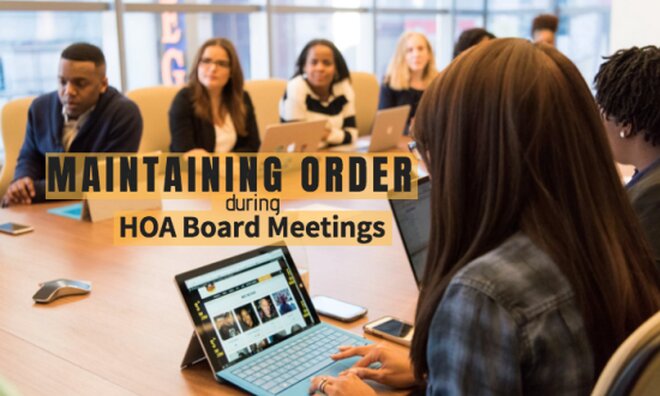While discussing important agenda items is vital, keeping a debate moving on to the next agenda item and keeping a discussion on the topic is crucial.

How to Maintain an Orderly HOA Board Meeting
HOA members, regardless of the size of the association, are busy juggling many responsibilities. Work, family and home improvement take up most of the time that is not devoted to sleep. With that in mind, directors should remember that while they are the decision makers, they and all their fellow members are human and occasionally display their shortcomings at board meetings – even when meeting rules are in force.
Whether your association has 20 homes or 2,000, respectful conduct and order should be maintained at board meetings. But we are human, and there are times when frustration and impatience take over that meetings can become sources of contention, especially when a member is dismissed out of hand, or feels his or her concerns have been ignored over a period of time.
Challenges Facing Smaller HOAs
Smaller associations without rec rooms or meeting centers generally are more informal, with meetings held usually at one of the director’s homes. Decorum is generally looser since the association members are tighter knit and members are almost always on the same page when it comes to knowing issues that should be addressed in the short term as well as long term. With intimacy, however, comes occasional controversy and contention that can arise during the course of a board meeting (or in the common area before a meeting). Because smaller sized HOAs have a comparatively limited number of directors, the effect of a disruptive member is more immediate and should be addressed without delay.
As an example, one such smaller association (14 units) had had a persistent problem with residents placing belongings in front of their parking places in the property’s underground parking lot. This behavior is against CC&Rs and monthly penalties are assessed for the repeat, persistent violators. One homeowner was warned on several occasions that his renter needed to stash his belongings elsewhere, as not only was this against rules, but it was also a fire department violation that could incur fines against the HOA upon inspection. The behavior continued, penalties continued to pile up, and the homeowner, who never attended board meetings, decided to finally attend, and during the open forum portion of the meeting, launched a 15 minute invective on the unfairness and excessiveness of the penalties assessed against him (approximately $2000 over the course of 18 months). Despite attempts to forestall him, he continued virtually unabated, in an effort to have the entire debt scrubbed from his account. Having done little to further his cause, the board later met in executive session to reduce it somewhat, with the stipulation that, if the debt was not resolved by the homeowner in a timely manner, it would be resolved once his home was sold. During that executive session, the directors also decided upon future rules of conduct, limiting individual open forum time and that any lengthy issues be addressed in writing to both the management company and to the board.
Averting Disruption at Larger Association Board Meetings
Larger HOAs face a different set of challenges altogether. These communities have a board with several more members than a smaller HOA, and with the more expansive board come more potential disruption problems during meetings. In order to encourage attendance and to keep a healthy turnaround of directors from year to year, it’s important to nip these issues in the bud as soon as they begin.
Instead of the collegiality of a smaller HOA, where members, while adhering to rules of order, meet more casually, larger association meetings are more formal, employing stricter time schedules to keep meetings from becoming marathon complaint sessions. It’s also important to encourage deliberation amongst the directors, should an agenda item come to a vote. Members feel confident with this level of transparency, however, if the agenda item is particularly contentious and requires a great deal of discussion time, directors may experience difficulty maintaining control. While keeping the meeting on a schedule is important, it’s critical that members’ issues are reasonably vented for further consideration, which may mean a longer time block allocated to a specific agenda item, or to the open forum. Directors should remain mindful regarding open forum time to make sure that homeowners are able to air their comments and that their comments are committed to meetings notes recorded by the board secretary.
Remain Focused and Timely
Directors should always make the assumption that their fellow members have a family and work life and do not wish to spend 4 hours at an HOA board meeting – no matter how important the issues may be. While discussing important agenda items is vital, keeping a debate moving on to the next agenda item and keeping a discussion on the topic is crucial. At this time directors should exercise diplomacy and keep members aware that agenda items should be discussed in an orderly manner, one at a time, on topic. Should any member become disruptive, use your better judgment to diffuse the member, from initiating a vote on an agenda item to asking the person to leave. If any items remain unresolved, they can be tabled to the next board meeting or, if urgent, handled via committee through email or a subsequent committee meeting that reports its findings to the board at large at a subsequent meeting.
Long meetings may appear productive because of the length of discussion, but they also can lead to imprudent decision making by fatigued directors, and an equally tired membership that veers off the agenda to points unknown. To avoid these problems, keep your agenda simple and make sure directors read associated agenda materials ahead of time (whether via hard copy or email). HOA members in attendance do not want to wait for directors to read through a 10-page construction bid during the meeting and then vote on it.
Ultimately the board must build a trust between itself and the membership to help ensure that, while bad behavior is discouraged, disagreement is not. With constructive disagreement comes learning, and the realization that when the decision making process involves the general membership, a better result can be achieved. The outcome: a more harmonious community.
